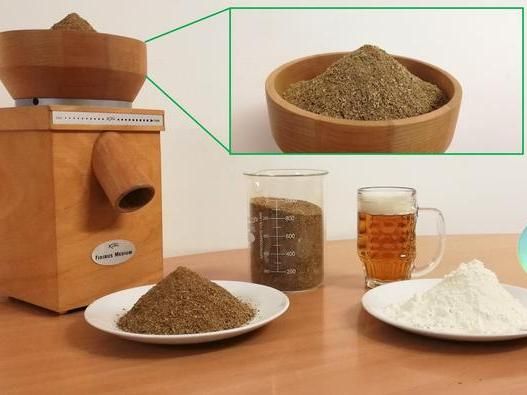Bread from brewery waste?
Researchers study health benefits of brewer's grains
Advertisement
Brewer's grains are produced in large quantities as a by-product of brewing. The fibrous grain residues are mostly used as animal feed or end up in the trash. Yet they are potentially a valuable source of food. Pharmacists led by Professor Claus Jacob at Saar University have investigated whether spent grain could be used as a flour substitute in bread production - and what health benefits might be associated with it - in the cross-border "Bioval" project. The results have now been published in the journal "Food & Function".

Brewer's grains, a by-product of beer brewing, can be used for bread baking: in dried, ground form or as flour.
Yannick Ney
Brewing beer in Germany produces around 4000 tons of spent grain every day - this is grain residue such as "spent" barley grains. The brown, fibrous mass accounts for about 85 percent of the byproducts in the brewing industry. It is produced in the brewing process before fermentation, so it contains no alcohol. Some is used as animal feed, compost or for methanation, but it also often goes to waste. "The dried spent grain still contains many ingredients of the grain that are not water-soluble," explains Claus Jacob, professor of bioorganic chemistry at Saarland University. That means lots of dietary fiber (40%) and protein (25%), but also fats, minerals and secondary plant compounds, such as phenols and flavonoids, which can have antioxidant and anti-inflammatory effects in the body.
Could the waste product spent grain thus be a valuable source of nutrition and possibly also be used as a functional food, for example against chronic inflammatory diseases? - To investigate this question, the Saarbrücken team led by Claus Jacob joined forces with research groups from the greater region as part of the EU project "Bioval" to examine whether spent grain is suitable for the production of bread. They used both moist spent grain and dried and ground spent grain, which can be used like flour. The material was made available to them by breweries in the greater region and by the Technical University of Kaiserslautern. When making the bread dough, the spent grains were added in varying proportions as a flour substitute. In the process, Claus Jacob and his colleagues were first active as bakers themselves before bread baking was tested under real conditions in a professional bakery: the Steigleiter confectionery in Saarbrücken, which produced various samples of spent grain bread.
"Up to a proportion of five to ten percent spent grains, the breads were very good to eat; with higher proportions of 20 percent spent grains and more, it didn't taste as good," the pharmacy professor reports of the taste experience during the tasting. However, even higher proportions could certainly be used in fritters and burgers, as a fibrous taste experience is definitely desired there.
But what are the health benefits of adding spent grains to bread or brats? - "The bread is high in protein and contains a lot of fiber, which is clearly beneficial to health," explains Claus Jacob. "Since most people consume much less fiber than recommended - 25 grams per day for women and 38 grams for men - the addition of spent grain can be both a beneficial and healthy source of fiber."
To find out to what extent the secondary plant compounds in spent grain bread could also have a positive effect on health, the digestion of the bread in the gastrointestinal tract was studied using a cell model. It was found that the phenolic ingredients and associated antioxidant activity were still present after digestion, but to a lesser extent. "The extent to which the amount of phytochemicals in spent grain bread is sufficient to provide authoritative health benefits would need to be verified in further studies," Jacob concludes.
The Saarbrücken scientists consider the results of their study encouraging: "We have seen that spent grain is clearly suitable as a building block for the circular economy: By using it, we can enrich bread and at the same time save flour and avoid waste," sums up Claus Jacob. However, fresh spent grain has to be processed quickly; an alternative is to refine it further: Dried, ground and sold as flour, the spent grains could be produced and stored in larger quantities. - Incidentally, the Saarbrücken scientists are not the first to look into this type of bread production: "Brewer's grains have a long tradition: They were already baked in the Middle Ages, but today they are quite out of fashion. In terms of sustainable management and because of its health benefits, it could and should be used more again," appeals Prof. Claus Jacob.
The study by the Saarbrücken scientists was carried out in cooperation with the Luxembourg Institute of Health, the University of Milan and the Belgian company CELABOR. It is part of the cross-border EU project "Bioval", which was funded for four years with around 1.8 million euros as part of the EU's Interreg program. Under the title "Bioval: upcycling of breweries' waste," researchers from the greater region investigated the conversion of spent grain into new products: for example, biodegradable tableware, spent grain flour or vinegar. Background: In the beer production regions of Belgium, Germany, Luxembourg and France, a large proportion of the spent grains produced is either used as a feed additive or for biogas production, or disposed of as biowaste at high cost.
Note: This article has been translated using a computer system without human intervention. LUMITOS offers these automatic translations to present a wider range of current news. Since this article has been translated with automatic translation, it is possible that it contains errors in vocabulary, syntax or grammar. The original article in German can be found here.





















































